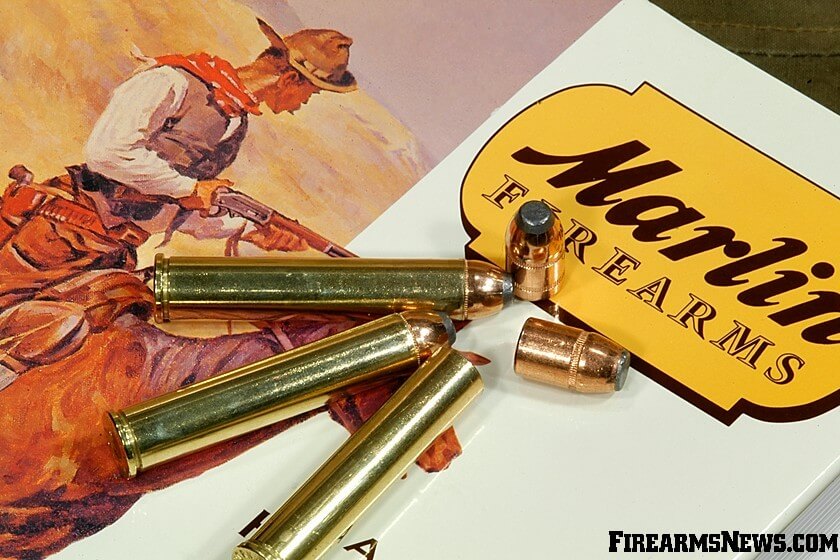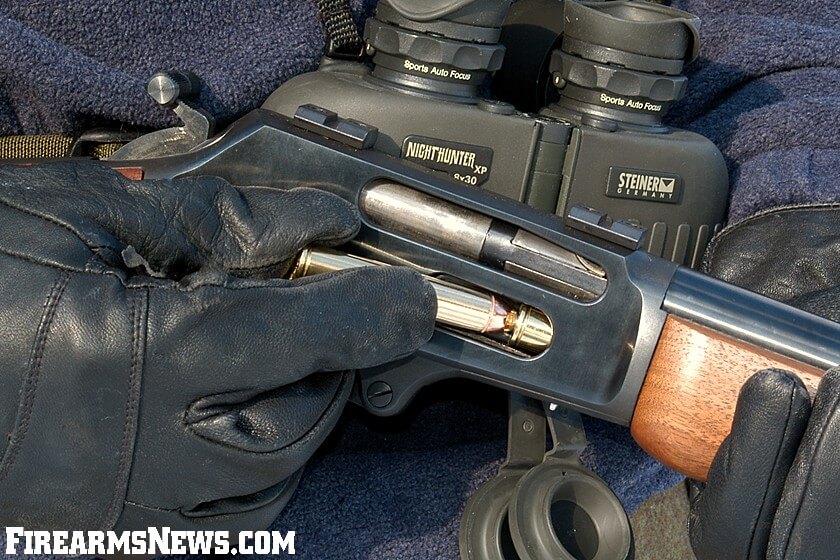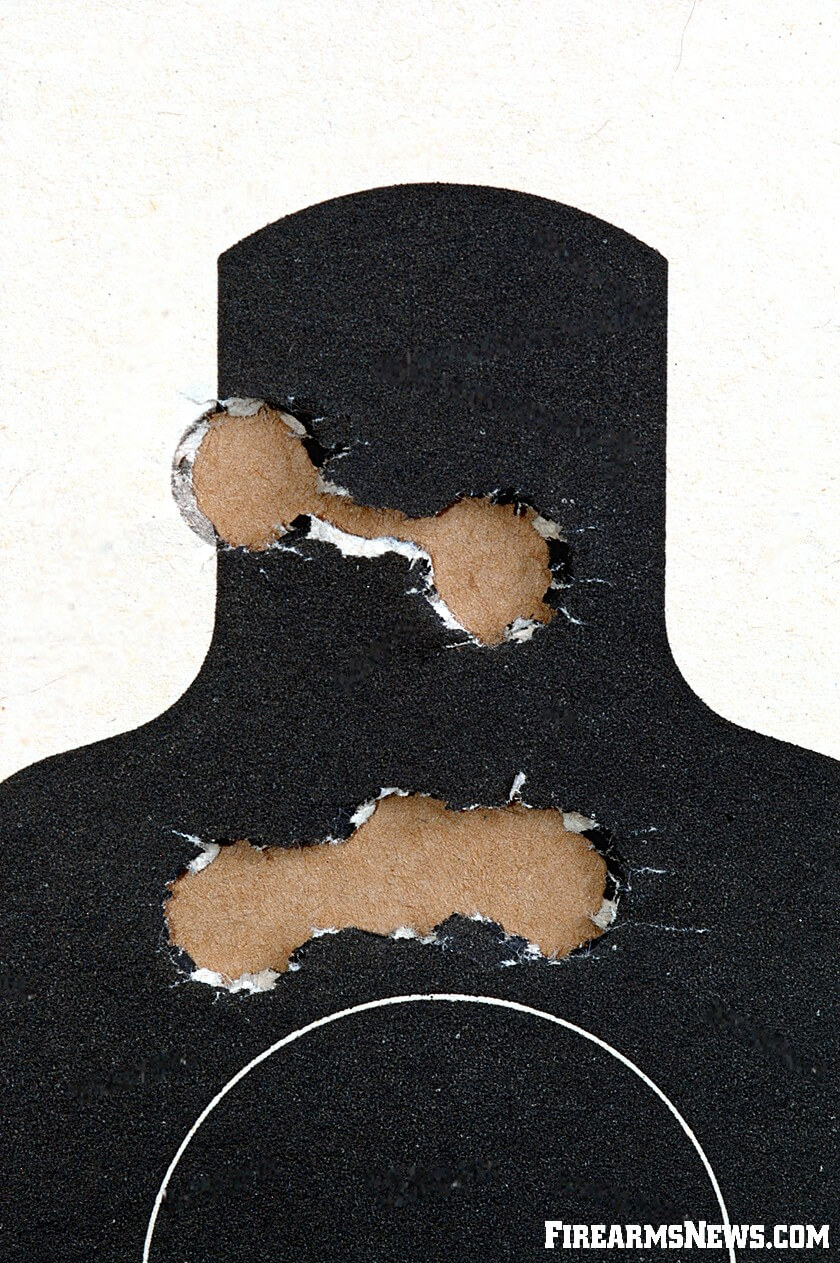When Did Marlin Start Making the 444 Rifle Again
The .444 Marlin Cartridge in Review
Big-Bore lever-guns remain very popular, but you may desire to consider one chambered in .444 Marlin over .45-70 Government!

While resembling a child of the 19th Century, the .444 Marlin is actually a modern high-force per unit area cartridge. Authentic and hard-hit, it's well-suited to hunting in heavy cover.
April 21, 2021
Even in a earth awash with mod bolt-guns chambered in hot vi.5mm cartridges the elementary big-bore lever gun remains hugely pop with many. Models like the Marlin (MarlinFirearms.com)1895 Night Serial, reviewed hither, are in high demand. The reason is simple enough, they are quick handling, carry well, authentic enough and hit very hard. While the classic .45-70 Government cartridge is a favorite, you should not overlook the .444 Marlin cartridge. A well idea out and modern blueprint, the "Triple 4" is capable of excellent accuracy and, with the right loads, able to drop any game animal in North America.
A true sixties child, the .444 Marlin was conceived by two Marlin employees. Thomas Robinson, Marlin'south managing director of research, and Arthur Burns, a metallurgist, adult this 19th Century looking round using an unfinished .30-'06 case equally a starting point. Drawn straight, and with a rim cutting into it, the cartridge was intended to put more punch into Marlin's lever action line. The prototype was presented to Remington who agreed to develop production ammunition. When Marlin introduced the Model 444 rifle chambering the new circular in 1965 it was the near powerful lever action rifle on the market.
The cartridge itself is deceptive in some ways. With its long straight-walled example, it appears as though information technology was designed with the depression pressures of black pulverization in mind. It wasn't. Then, there'south that name, .444 Marlin. Examining it, one soon learns it's no more a true .44 than the .44 Magnum is. Rather, it was designed to throw .429-inch diameter slugs intended for Harry Callahan'southward Magnum. Performance? Originally a 240-grain bullet was driven at close to 2,300 fps and delivered over three,000 ft-lbs. of energy.

Marlin offered the new cartridge in a nicely fabricated lever-action burglarize onto which modernistic optics could be hands mounted. It was quick-handling, accurate and offered very fast follow-up shots. The fly in the ointment were the projectiles. Driving a bullet designed for pistol velocities at over 2,000 fps did not provide optimum penetration and terminal functioning on really large and tough animals. When Marlin introduced a lever action .45-70 Regime model in 1972, the old military cartridge was destined to eventually eclipse the newer circular. This was mainly due to the .45-seventy Regime having stoutly constructed projectiles intended for rifle velocities readily available.
Despite the .45-70s re-emergence, the .444 Marlin has doggedly hung on and remains popular with many. It has a dedicated cult post-obit due to its impressive existent-world operation on big game, such as elk and moose. Over the years both projectiles and factory armament has improved further enhancing its operation. Although it's not widely loaded, Hornady does offer it in their LEVERevolution and Superformance lines loaded with 265-grain bullets. Buffalo Diameter offers three heavy loads running in weight from 270 to 335 grains, Underwood Armament loads the .444 Marlin as does Remington.

The traditional home for the .444 Marlin cartridge is a beefed-up version of the Model 336 rifle called, accordingly plenty, the Model 444. At 40.5 inches long and weighing just vii.v pounds, the Model 444 is right at abode hunting in thick cover. It carries wonderfully. Grasp it past the action and y'all tin can go all day without noticing it'south even there until you need it. When its services are required, the Marlin shoulders speedily, swings easily and speaks with authorization. As the rifle recoils, a reflexive swing of the hand ejects the spent cartridge case and chambers a fresh circular. Follow-up shots are very fast, with its merely real negative being a slow reload.
Performance? I checked my old information book to find some existent-world numbers. Hornady'due south one-time 265-grain JFP Lite Magnum load (now replaced in their line by their Superformance load) averaged i.3-inch five-shot groups at 100 yards. Velocity of this load averaged two,292 fps. Buffalo Bore's 270-grain JFP averaged one.5 inches at 2,245 fps. Then, accuracy is quite adept.

.444 Marlin Accurateness and Velocity Chart
Load: Buffalo Bore 270 grain JFP
Velocity: ii,245 fps
100 yards: 1.v inches
Load: Hornady Light Magnum 265 grain JFP
Velocity: 2,292 fps
100 yards: 1.3 inches
Note: Groups are an average of four five-shot groups fired from a remainder at 100 yards. Velocity readings are an average of 10 rounds recorded 15 anxiety from the muzzle with an Oehler 35P chronograph at 100 feet higher up Sea Level at an ambient temperature of 31 degrees F.
Punching the data into Sierra's Infinity Ballistic software churned upwardly some interesting numbers. Hornady's Light Magnum load generated 3,090 ft-lbs. of energy at the muzzle, two,074 ft-lbs. at 100 yards and 1,355 ft-lbs. at 200 yards. With a 150-yard cipher, this load is ane.viii inches high at 100 yards and only 4.8 inches low at 200 yards. To be edgeless, that's excellent performance from a lever action 'castor gun'. Need more steam? Buffalo Bore offers a heavier 300-grain JFP at an advertised 2,150 fps. Not enough? Well, if you need more horsepower and deeper penetration y'all can step up to their 335-grain WFN which pounds out at 2,025 fps.
Recommended
Want to handload? Consider Hornady dies, Barnes, Nosler, Speer, Remington and Hornady projectiles and Starline cases. For powders effort Reloader 7, IMR 4198 and H322. The .444 is a relatively piece of cake cartridge to load for, just call up to apply a adequately heavy crimp to prevent bullet set up-dorsum in the tubular mag under recoil.
While the .45-lxx Government may go the glory, Marlin's .444 is still a mighty fine cartridge. It offers admirable accuracy mixed with a healthy helping of raw big-diameter power. When combined with Marlin's Model 444 yous have a quick handling hunting rifle which hangs nicely for shots taken offhand. If you are hunting in heavy embrace the erstwhile "Triple 4" may exist all you lot want or need.
Well-nigh the author:
David Grand. Fortier has been covering firearms, ammunition and optics for 23 years. He is a recipient of the Carl Zeiss Outdoor Writer of the Year award and his writing has been recognized by the Civil Rights organisation JPFO. In 2007 he covered the state of war in Iraq equally an embedded journalist.
Source: https://www.firearmsnews.com/editorial/444-marlin-cartridge-review/391995